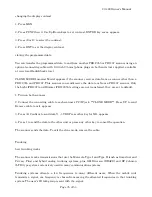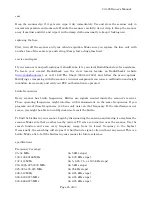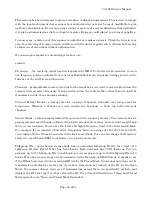
20-428 Owner’s Manual
Page 49 of 50
This scanner has been designed to prevent reception of illegal transmissions. This is done to comply
with the legal requirement that scanners be manufactured so as to not be easily modifiable to pick
up those transmissions. Do not open your scanner’s case to make any modifications that could allow
it to pick up transmissions that are illegal to monitor. Doing so could subject you to legal penalties.
In some areas, mobile use of this scanner is unlawful or requires a permit. Check the laws in your
area. It is also illegal in many areas to interfere with the duties of public safety officials by traveling
to the scene of an incident without authorization.
We encourage responsible, safe and legal scanner use.
glossary
Frequency – the receiving signal location (expressed in MHz). To find active frequencies, you can
use frequency guides available from your local RadioShack store, frequency listings posted on the
Internet, or the built-in search function.
Channels – programmable memory locations for the frequencies you want to monitor. Each time the
scanner finds an active frequency, it stops and monitors the radio traffic on that channel until the
transmission ends, then resumes scanning.
Channel Storage Banks – a storage area for a group of channels. Channels are storage areas for
frequencies. Whereas a channel can only contain one frequency, a bank can hold numerous
channels.
Search Banks – contain preprogrammed frequencies in the scanner’s memory. Your scanner has six
preprogrammed search banks configured to search various radio services, and one limit search bank
that you can configure. You can set the lower and higher frequency limit in the limit search bank.
For example, if you wanted to find active frequencies between a range of 150.1000 and 150.5000,
you would put both of those frequencies in the limit search bank. You can even change the frequency
range in a search bank (SR6) to customize your search parameters.
Talkgroup IDs – each channel storage bank has an associated talkgroup ID list, for a total of 10
talkgroup ID lists. Each ID list has 5 sub-banks. Each sub-bank has 30 ID locations. You can
program up to 150 talkgroup IDs in each bank, so you can program up to 1500 talkgroup IDs in 10
banks. When the scanner stops on a transmission in the Motorola or EDACS mode, it checks to see
if the ID has been stored in the associated ID list. In the Closed Mode, the scanner only stops on the
transmission and displays its text tag if you have stored and not locked out the ID. In the Open
Mode, the scanner always stops on all transmissions except those you specifically exclude, and
displays the ID’s text tag if you have stored the ID. For a detailed description of Open and Closed
Mode operation, see “Open and Closed Mode Operation”.


































